Sample Preparation Goes Subzero: Ice Concentration Linked with Extractive Stirrer (ICECLES)
A new technique, ICE concentration linked with extractive stirrer (ICECLES), provides highly efficient isolation of trace compounds from aqueous samples. ICECLES combines freeze concentration with stir-bar sorptive extraction into a seamless analytical extraction methodology.
A new technique, ice concentration linked with extractive stirrer (ICECLES), provides highly efficient isolation of trace compounds from aqueous samples. ICECLES combines freeze concentration with stir-bar sorptive extraction into a seamless analytical extraction methodology. This month, we discuss how to perform this relatively simple technique, and discuss its advantages and limitations.
Development of ice concentration linked with extractive stirrer (ICECLES) started, as many of my ideas start, with a modified scientific method, as described below.
Step 1: Observe an event and ask myself what causes the effect. In this case, it was answering the question, Why do soda cans sometimes “explode” as they freeze? I had witnessed this event multiple times when storing soda cans in the garage and forgetting to bring them into the house during the fall and winter in South Dakota. You might be asking: “Why are you storing soda in a garage in the winter in South Dakota?” I’ll just skip answering that, and get back to the question of why soda cans explode. The obvious first thought many of us have is that water expands when it freezes, causing pressure on the can, resulting in a breach. But if you have witnessed this phenomenon, you probably agree that the type of pressure needed to produce these sometimes violent explosions would not be generated by the relatively small volume change produced when water freezes. Also, fast freezing of the soda on really cold days did not cause the cans to explode, but slower freezing of the soda often did. This was further evidence that it was not the volume change, which should be independent of the rate of freezing, that caused the explosion. So, on to the next step.
Step 2: Form a hypothesis as to why this occurs. My hypothesis: As the water in the soda is freezing, the CO2 is being forced out of the water, and building up so much pressure that an explosion occurs. I was excited by this thought because, if true, this phenomenon could be used for analytical sample preparation. Here’s where my process diverges from the scientific method.
Step 3: Search the literature to evaluate if this phenomenon has been studied. Keep in mind that I don’t know what the phenomenon is called.
Step 4: Get really excited when I can’t find any trace in the literature and assume the phenomenon is novel. Ponder if I am the first to discover this interesting phenomenon, that I will be the first to study it, and maybe people will even call it the “Logue effect.”
Step 5: We simultaneously start laboratory experiments and I start writing a proposal to study this phenomenon. After I get about three-quarters of the way done with a proposal, I move on to Step 6.
Step 6: Find out the phenomenon has been studied and is well-characterized. Not only has it been studied, but, as typical of my “discoveries,” it was actually studied over 50 years ago. This was exactly the case for freeze concentration (FC) (1), also called freeze distillation or freeze fractionation (2), which was first mentioned by name in the patent literature in 1915 (3), and in a scientific article in 1951 (4), but was used farther back, likely for centuries, to concentrate food products (5).
Step 7: Depression ensues, but we still do some experimentation to see if we can take advantage of the phenomenon.
What is Freeze Concentration?
FC has received little attention in the field of analytical chemistry; however, it has been used for decades to concentrate solutes from solutions, and has found common application in the food industry for creating frozen concentrates of fruit juices, ice beer, and wine (6–11). As the name implies, FC is a technique for concentrating solutes by freezing a solution. Solutes are concentrated based on the relationship between freezing point depression and solute molality, where local regions of solvent with low solute concentration are frozen first, and the solution left behind is more concentrated. Unless this process is controlled, the rate of freezing is generally too fast to freeze out pure solvent (12,13), but the efficiency of FC can be increased by controlling the freezing process. For example, stirring the solution vigorously and controlling the freezing rate can allow freezing of almost pure solution. Although FC is typically used to concentrate complex solutions (such as fruit juices), previous studies demonstrated that the efficiency of FC increases as solute concentrations decrease (1,12–15), thereby also lending itself to ultratrace analysis.
History of Freeze Concentration in Analytical Chemistry
Shapiro first suggested the use of FC for concentrating dilute solutions for analysis in 1961 (16) and continued to do so in follow-on work in 1967 (17). In the late 1960s, others built on Shapiro’s work to confirm that FC could be effectively used to concentrate “dilute” aqueous solutions (18–23). For example, Baker (19,20) concentrated organic compounds with initial concentrations in the µg/mL to ng/mL range for analysis by gas chromatography (GC). Kepner and associates (23) concentrated dilute solutions (in the low to mid µg/mL levels) of “volatile” organic compounds by FC, and found that concentration factors of 5 to 40x could be achieved, along with recoveries of over 90%. Although these applications indicated that FC was useful for general analytical concentration, further study of the technique for analytical purposes decreased precipitously around 1970, and it currently remains highly underutilized for analytical sample preparation. In fact, over the last 10 years, aside from ICECLES, we found its use for analytical purposes in only a handful of publications: 1) Balazy and colleagues (24) used FC to concentrate a glutathione NO3- mixture to isolate a glutathione-NO2 product, and 2) Okada evaluated FC for its “partitioning-like” behavior (25–28) and for preconcentration of analytes for capillary electrophoresis (29).
Combination of Stir-Bar Sorptive Extraction with FC
So, getting back to the story of ICECLES…after my dreams of discovering a novel process had evaporated, I decided that we should continue to play around with FC in the laboratory to see how useful it was for analytical sample preparation. To make a long story short, we were surprised to find that when we froze an aqueous sample in a distinct, but simple, manner, the stir bar didn’t get stuck in the ice, even when fully freezing the aqueous sample (30,31). Specifically, the solution is stirred quickly (typically at 1200 rpm), as it is frozen directionally from the bottom of the vial to the top. Figure 1 shows a visual example of this process using an aqueous solution with a blue dye. Imagining that the analyte of interest is the blue dye, the analyte is concentrated very well through the freezing process into the remaining solution and only freezes into the last volume of ice. Interestingly, even at the top of the ice, the dye is not uniformly concentrated; it is more concentrated at the middle of this layer, near the stir bar (Figure 1c). I was so surprised by this phenomenon that we repeated the experiment about twenty times before I believed this was reproducible. Once I was convinced, I realized that stir-bar sorptive extraction (SBSE) would be perfectly suited to combine with FC to produce FC-SBSE, which we lovingly dubbed ICECLES. We felt FC and SBSE would be highly complementary, since FC concentrates analytes into a solution that is stirred. The increased analyte concentration in solution would cause concentration stress on the equilibrium between the analyte in the solution and the sorptive phase of the stir bar, resulting in increased extraction. Figure 2 shows this concept schematically. Since PDMS is quite hydrophobic, analytes with high log Kow >3 (yellow diamonds in Figure 2), already work well via SBSE, so FC isn’t necessary for efficient extraction, but ICECLES also should not disrupt efficient extraction of highly hydrophobic analytes. If analytes have log Kow ≈ 0 to 3 (called “intermediate hydrophobicity;” green triangles in Figure 2), ICECLES works very well to increase the extraction efficiency. Even compounds with intermediate hydrophilicity (log Kow ≈ -3 to 0; red squares in Figure 2) can be extracted into the stir bar using ICECLES when they would normally have extremely low extraction efficiency with PDMS as the sorptive phase. As the hydrophilicity increases, at some point, molecules will not migrate into the stir bar, no matter how efficient the FC. These compounds are very hydrophilic (log Kow < -3; blue circles in Figure 2), and should be prepared via a different technique.
Figure 1: Images of the freeze concentration process for an aqueous solution containing a blue dye (5 mL) using vigorous stirring (1200 rpm) with a common polytetrafluoroethylene-coated stir bar and freezing from the bottom to top of the vial. The figure shows the side (left) and top (right) views of the vial at different stages of freeze concentration: (a) initial solution of dye, (b) the sample after freezing half the solution volume, and (c) the completely frozen sample.
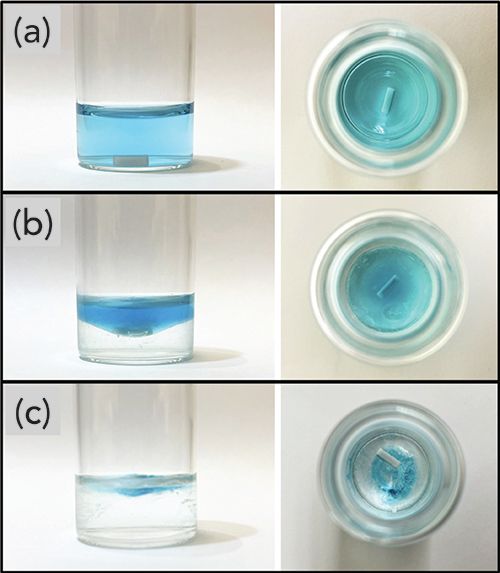
Figure 2: Schematic of the ICECLES extraction process for compounds with a range of Kow values: 1) very hydrophobic (log Kow > 3; yellow diamonds), 2) intermediate hydrophobicity (log Kow 0–3; green triangles), 3) intermediate hydrophilicity (log Kow = -3–0; red squares), and 4) very hydrophilic (log Kow < 3; blue circles).
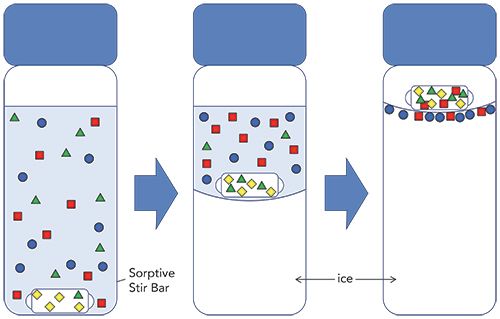
Main Advantages of ICECLES and Its Applications
ICECLES offers several advantages, with the most important being as 1) increased extraction efficiency leading to increased sensitivity for many difficult-to-extract compounds; 2) automated sample preparation; 3) relatively low sample volume requirements; and 4) no organic solvents. Some other modern analytical sample preparation techniques also share some of these advantages, but ICECLES really shines for comprehensive and ultratrace analysis. It works especially well for compounds with intermediate hydrophobicity, while conserving the ability to extract very hydrophobic molecules. For example, ICECLES has been used to evaluate the composition of green tea (30), and has been used for ultratrace analysis of pesticides (31), nitrosoamines (32), and other compounds (31). An example of the use of ICECLES for ultratrace analysis is the analysis of nitrosodipropylamine (NDPA; log Kow = 1.36) from drinking water (32). NDPA is extremely toxic (33) but very difficult to detect at concentrations of concern (for example, maximum reporting limits are in the low pg/mL), leaving analysts with no option but to use highly sophisticated and expensive instrumentation, large sample volumes (typically 500–1000 mL), and long and arduous sample preparation in order to detect low pg/mL concentrations of nitrosamines (34–42). Using ICECLES, we were able to detect 0.2 pg/mL levels of NDPA in only 5 mL of drinking water using a standard GC–MS instrument with electron ionization. ICECLES also allowed ultratrace detection of pesticides from environmental water sources (31). The first application of ICECLES for comprehensive analysis was for aroma and flavor analysis of green tea. ICECLES permitted identification of many more compounds than SBSE (301 versus 245) (30). It did especially well for aldehydes and pyrazines, which are very important for aroma and flavor, but which are difficult to detect with other sample preparation techniques.
For this article, we compared the extraction efficiency of ICECLES to other common microextraction techniques by performing ICECLES extractions of an aqueous sample of 313 pesticides spiked at 100 pg/mL into purified water. We compared the ICECLES results to SBSE and SPME extractions of the same sample. All extractions were accomplished using a 10-mL sample, with PDMS as the sorbent phase (0.612 µL for SPME and 24 µL sorbent phase volume for ICECLES and SBSE), direct immersion of the fiber or stir bar for 2.5 h, and back extraction with acetonitrile:water (1:1, v:v) (55 µL for SPME and 500 µL for SBSE and ICECLES). Liquid chromatography-tandem mass spectrometry (LC–MS/MS) analysis of the back extracts was performed using the same method. Figure 3 shows the chromatograms produced from these extractions. ICECLES clearly produces greater extraction efficiencies than both SBSE and SPME, as demonstrated by more numerous and intense peaks in the ICECLES chromatogram. Figure 4 shows a more quantitative evaluation of the data where signal enhancement (peak area ratio of the analyte extracted via ICECLES versus either SBSE or SPME) is plotted for each analyte that was detectable by each technique. ICECLES produced increased signals up to 10x and 120x for SBSE and SPME, respectively. Moreover, ICECLES produced detectable signals, with a signal-to-noise ratio (S/N) ≥ 3, for 273 of the 313 compounds at this concentration (87%), whereas SBSE and SPME allowed detection of 229 (73%) and 192 (61%) compounds, respectively.
Figure 3: Chromatograms of a suite of pesticides (n = 313, each spiked at 100 pg/mL) extracted from a water sample (10-mL) using (a) ICECLES, (b) SBSE, and (c) SPME. ICECLES extraction produced increased signals for most of the pesticides analyzed.
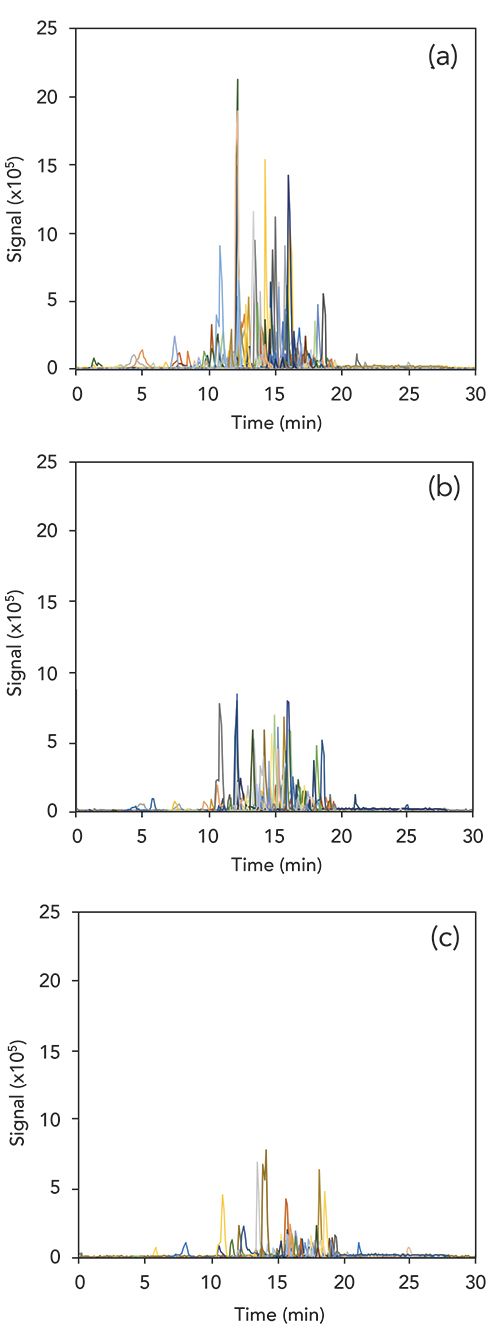
Figure 4: Signal enhancement of ICECLES as compared to SBSE and SPME. The signal enhancement is calculated as the peak area of a pesticide extracted via ICECLES divided by the peak area of the same pesticide extracted by SBSE or SPME. Note: Although 313 pesticides were present in the sample, the whisker plot is based on the signal enhancement for only pesticides that produced detectable signals for both ICECLES and SBSE (n = 229) or SPME (n = 192).
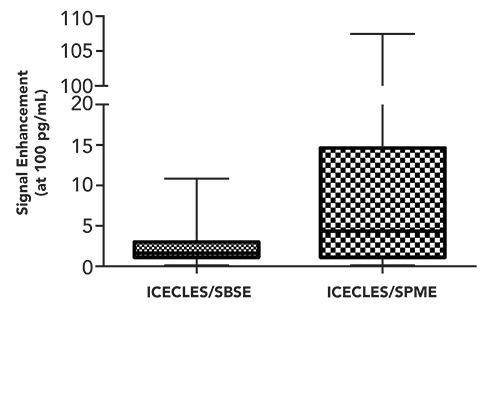
Limitations of ICECLES
The main limitations of ICECLES are obviously associated with the need to freeze the sample. A 5–10 mL sample of water takes around 2 to 3 h to freeze under standard ICECLES conditions. This is more time than it takes for a typical SPME or SBSE analysis (< 1h). Depending on the analyte, sorbent, and analytical requirements of the method, solid-phase extraction and liquid-liquid extraction can also be quicker than ICECLES, requiring as little as 15 min, but they can also take hours and require constant attention (for very large sample volumes). Aside from potentially increased sample preparation time, ICECLES is limited by its ability to directly analyze extremely complex samples, because the efficiency of FC can degrade as the complexity of the sample increases. For example, as the organic content of the sample increases (such as, for example, from that of drinking water to that of alcoholic beverages), the efficiency of FC decreases, to the point where a portion of a sample might not freeze unless much lower temperatures are used. Creative sample preparation may allow ICECLES analysis of these samples, but the extra effort may not be worth it, depending on the analytical requirements. Lastly, while not a limitation attributed to ICECLES itself, no application of ICECLES outside of our laboratory has been published to date.
Conclusion: Just Try It
While ICECLES is not for everything or everyone, it has shown a great propensity for ultratrace analysis and comprehensive analysis. Especially if either of these situations apply to your analysis, ICECLES will likely work extremely well. It is also likely to work well for pesticide screens, such as the one presented here, but this should be verified in a stand-alone study using more realistic samples. So, similar to a famous slogan, we encourage you to “Just try it!” While we cannot guarantee it will work for your individual application, it is very likely that it will perform well based on our experience.
References
- R. Halde, Water Research 14, 575–580 (1980).
- J. Shwartz and R.F. Probstein, Desalination4, 5–29 (1968).
- M. Rane and Y. Padiya, Indian Patent Application (1915).
- R. Heiss and L. Schachinger, Food Technol.5, 211–218 (1951).
- A. Stewart, The Drunken Botanist (Algonquin Books, Chapel Hill, North Carolina, 2013).
- L. Liu, O. Miyawaki, and K. Hayakawa, Food Sci. Technol. Res.5, 108–112 (1999).
- L. Bayindirli, M. Özilgen, and S. Ungan, J. Food Eng. 19, 95–107 (1993).
- R. Hartel, and L. Espinel, J. Food Eng. 20, 101–120 (1993).
- S. Deshpande, M. Cheryan,S.K. Sathe, D. Salunkhe, and B. Luh, Crit.Rev. Food Sci. Nut. 20, 173–248 (1984).
- H.A. Thijssen, Process for Concentration of Alcoholic Beverages, US Patent 4,265,920 (1981).
- R. Essery, R. Gane, and T. Morris, J. Inst. Brew. 153, 204–208 (1947).
- O. Miyawaki, L. Liu, and K. Nakamura, J. Food Sci.63, 756–758 (1998).
- R. Fujioka, L.P/ Wang, G. Dodbiba, and T. Fujita, Desalination319, 33–37 (2013).
- Y. Dai, Y. Zhang, B. Liu, M. Teduka, Y. Lin, and S. Tanaka, Environmental Engineering and Management Journal 10, 955–958 (2011).
- O. Miyawaki, L. Liu, Y. Shirai, S. Sakashita, and K, Kagitani, J. Food Eng. 69, 107–113 (2005).
- J. Shapiro, Science133, 2063–2064 (1961).
- J. Shapiro, Anal. Chem. 39, 280 (1967).
- P.A. Kammerer Jr and G.F. Lee, Environ. Sci. Technol. 3, 276–278 (1969).
- R.A. Baker, Water Research 1, 97–113 (1967).
- R.A. Baker, Water Research1, 61–77 (1967).
- R.A. Baker, J - Water Pollut. Control Fed. 1164–1170 (1965).
- S. Kobayashi and G.F. Lee, Anal. Chem. 36, 2197–2198 (1964).
- R.E. Kepner, S. Van Straten, and C. Weurman, J. Agric. Food Chem. 17, 1123–1127 (1969).
- M. Balazy, P.M. Kaminski, K. Mao, J. Tan, and M.S. Wolin, J. Biol. Chem.273, 32009–32015 (1998)
- T. Okada and T. Kuwamoto, Anal. Chem.55, 1001–1004 (1983).
- H. Watanabe, T. Otsuka, M. Harada, and T. Okada, J. Phys. Chem. C118, 15723–15731 (2014).
- Y. Tasaki, and T. Okada, J. Amer. Chem. Soc.134, 6128-6131 (2012).
- T. Hashimoto, M. Harada, S. Nojima, and T. Okada, ChemPhysChem14, 3410–3416 (2013).
- K. Ito and T. Okada, Anal. Methods5, 5912–5917 (2013).
- A. Alluhayb and B.A. Logue, J. Chromatogr. A 1518, 8–14 (2017).
- N. Maslamani, E. Manandhar, D.K. Geremia, and B.A. Logue, Anal. Chim. Acta941, 41–48 (2016).
- J. Dzisam and B.A. Logue, J. Chromatogr. A1604, 460468 (2019).
- D. Heath, Biochem. J.85, 72 (1962).
- J.W.A. Charrois, M.W. Arend, K.L. Froese, and S.E. Hrudey, Environ. Sci. Tech. 2004, 38, 4835–4841 (2004).
- J.W. Munch and M.V. Bassett, J. AOAC Int.89, 486–497 (2006).
- Y.Y. Zhao, J. Boyd, S.E. Hrudey, and X.-F. Li, Environ. Sci. Tech.40, 7636–7641 (2006).
- M. Krauss and J. Hollender, Anal. Chem.80, 834–842 (2008).
- C. Planas, O. Palacios, F. Ventura, J. Rivera, and J. Caixach, Talanta76, 906–913 (2008).
- Analysis of Nitrosoamines in Drinking Water Uising the Agilent 5977A Series GC/MSD System (Agilent, 2013).
- Y. Qian, M. Wu, W. Wang, B. Chen, H. Zheng, S.W. Krasner, S.E. Hrudey, and X.-F. Li, Anal. Chem. 87, 1330–1336 (2015).
- R.C. Cheng, C.J. Hwang, C. Andrews–Tate, Y.C. Guo, S. Carr, I.M. Suffet, J. – Am. Water Works Assoc. 98, 82–96 (2006).
- C. Ripollés, E. Pitarch, J.V. Sancho, F.J. López, and F. Hernández, Anal. Chim. Acta702, 62–71 (2011).

Brian A. Logue is a Professor in the Department of Chemistry and Biochemistry at South Dakota State University.
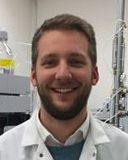
Chris Skaggs is a residue chemist and manages the GLP chemistry laboratory for SGS North America, in Brookings, South Dakota.

Abdullah H. Alluhayb is a teaching assistant at Qassim University in Saudi Arabia.

“Sample Prep Perspectives” editor Douglas E. Raynie is a Department Head and Associate Professor at South Dakota State University. His research interests include green chemistry, alternative solvents, sample preparation, high-resolution chromatography, and bioprocessing in supercritical fluids. He earned his PhD in 1990 at Brigham Young University under the direction of Milton L. Lee. Raynie is a member of LCGC’s editorial advisory board. Direct correspondence about this column via e-mail to LCGCedit@ubm.com
Study Explores Thin-Film Extraction of Biogenic Amines via HPLC-MS/MS
March 27th 2025Scientists from Tabriz University and the University of Tabriz explored cellulose acetate-UiO-66-COOH as an affordable coating sorbent for thin film extraction of biogenic amines from cheese and alcohol-free beverages using HPLC-MS/MS.
Multi-Step Preparative LC–MS Workflow for Peptide Purification
March 21st 2025This article introduces a multi-step preparative purification workflow for synthetic peptides using liquid chromatography–mass spectrometry (LC–MS). The process involves optimizing separation conditions, scaling-up, fractionating, and confirming purity and recovery, using a single LC–MS system. High purity and recovery rates for synthetic peptides such as parathormone (PTH) are achieved. The method allows efficient purification and accurate confirmation of peptide synthesis and is suitable for handling complex preparative purification tasks.
